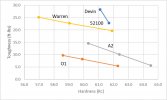Larrin
Gold Member
- Joined
- Jan 17, 2004
- Messages
- 5,039
Information about the development of A2 steel and when it began to be used in knives. Also testing of heat treatment and toughness of A2, and comparisons with other available knife steels. https://knifesteelnerds.com/2019/04/22/a2-steel-history-and-properties/

 Even so, I think that there are very skilled bladesmiths that can deliver a very tough knife heat treated with a charcoal forge (or gas forge) and “simple” oil, as mankind used to make blades in the past. Theses guys have very trained eyes and can probably (without scientific proof, at least that I know of) achieve the toughness peak of the steels by the colors and probably by trial/error. But no doubt that a controlled heat treatment setup would deliver allways same (good) results, if all the steps are the same, of course, and the steel is from the same (very clean and high quality) batch.
Even so, I think that there are very skilled bladesmiths that can deliver a very tough knife heat treated with a charcoal forge (or gas forge) and “simple” oil, as mankind used to make blades in the past. Theses guys have very trained eyes and can probably (without scientific proof, at least that I know of) achieve the toughness peak of the steels by the colors and probably by trial/error. But no doubt that a controlled heat treatment setup would deliver allways same (good) results, if all the steps are the same, of course, and the steel is from the same (very clean and high quality) batch.